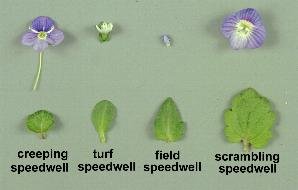Speedwell in Lawns
Speedwell is a small, low-growing weed that loves to hide in New Zealand lawns. It comes in several forms—field speedwell, scrambling speedwell, creeping speedwell, and turf speedwell—and all of them can be tricky to identify and even harder to remove.
They tend to appear through autumn and winter, forming tight mats that creep through the grass. Because most species grow below mower height, mowing alone rarely helps. Once speedwell takes hold, it can outcompete finer lawn grasses, leaving thin, patchy areas that struggle to recover.
Speedwells thrive in compacted or nutrient-poor soils and are particularly common in shaded, damp parts of the lawn. While each species behaves slightly differently, their growth habits and control methods are largely the same.
Identification
Speedwell species share similar traits: small rounded leaves, fine stems that form low mats, and tiny blue or white flowers. The main differences are in the leaf shape, hairiness, and whether the stems root as they spread.
Field Speedwell (Veronica arvensis)
- Hairy leaves forming a compact rosette
- Small blue flowers that grow close to the stem base
- Does not produce creeping stems
- Heart-shaped seed pods
- Common in compacted and shaded lawns
Scrambling Speedwell (Veronica persica)
- Slightly larger than field speedwell
- Hairy stems that scramble through grass but don’t root along the nodes
- Small sky-blue flowers with white centres
- Prefers open areas of lawn and garden edges
- Can quickly spread by seed if not controlled before flowering
Creeping Speedwell (Veronica filiformis)
- Very low-growing with stems that root at multiple points
- Rounded, scalloped leaves and tiny pale blue flowers
- Forms thick mats that crowd out lawn grass
- Extremely persistent once established
Common in cool, moist, shaded areas such as under trees or along fence lines
Turf Speedwell (Veronica sublata)
- Small, hairless leaves with mainly white flowers
- Grows very flat and tight to the soil surface
- Tolerates close mowing better than other types
- Often mistaken for field speedwell but lacks leaf hairs and stays greener in winter

Why It’s a Problem in Lawns
Speedwell doesn’t look dramatic, but it can quietly ruin a lawn’s appearance. It spreads through thin or patchy turf, filling bare areas with wiry stems and small leaves that disrupt the even texture of grass. Because most species grow flat against the ground, mower blades pass right over them.
Speedwell thrives where the soil is compacted or low in fertility, or where grass coverage has thinned out from drought or shade. Once it becomes established, selective herbicides struggle to move through the hairy leaves and stems, making control difficult.
Control in Home Lawns
Speedwell is resistant to many of the herbicides commonly used for broadleaf weeds in lawns. Timing and persistence are key—target young plants during their early growth stages in autumn or early spring.
Best control methods:
- Physical removal: Hand-pull small patches, making sure to remove all creeping stems and roots. This works best when the soil is moist.
- Chemical control: Most speedwell species resist MCPA, 2,4-D, clopyralid, and picloram/triclopyr mixes like NZLA Gold. For better results, use a product containing ioxynil or bromoxynil, such as Image (ioxynil + bromoxynil + mecoprop). These actives give better results on established plants.
- Pre-emergent control: Herbicides containing diflufenican (as found in NZLA BWC) can help suppress new seedlings in autumn.
- Cultural management: Reduce compaction, fertilise regularly, and overseed thin areas to maintain a dense lawn canopy that limits reinfestation.
Prevention Tips
- Keep the lawn healthy and dense to crowd out speedwell seedlings.
- Fertilise in early spring and autumn to encourage strong grass growth.
- Aerate compacted soil annually to improve drainage and oxygen flow.
- Avoid mowing too low, as scalping weakens grass and exposes bare soil.
- Watch shaded, damp areas closely, speedwell thrives where grass struggles.